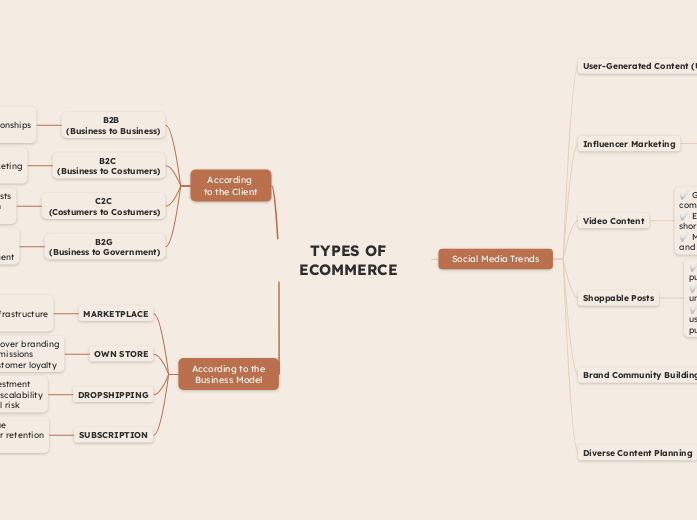TYPES OF
ECOMMERCE
Social Media Trends
User-Generated Content (UGC)
✅ Greater credibility and trust in the brand.
✅ Low investment in traditional advertising.
✅ Increased engagement with real customers sharing experiences.
Influencer Marketing
✅ Higher ROI (Return on Investment) compared to traditional advertising.
✅ Better audience segmentation by collaborating with influencers aligned with the brand.
✅ Generates organic recommendations, increasing purchase intent.
Video Content
✅ Greater reach and engagement compared to images or text.
✅ Easy to consume, adapted to users' short attention spans.
✅ More effective for explaining products and services visually.
Shoppable Posts
✅ Facilitates conversion, allowing purchases directly from social media.
✅ Reduces purchase time, eliminating unnecessary steps in the buying process.
✅ Provides greater convenience for users, increasing the likelihood of purchase.
Brand Community Building
✅ Strengthens customer loyalty, increasing retention rates.
✅ Encourages user interaction, creating brand ambassadors.
✅ Provides valuable insights into customer preferences and needs.
Diverse Content Planning
✅ Greater organization and consistency in digital marketing strategies.
✅ Boosts creativity by experimenting with different types of content.
✅ Optimizes time and resources, reducing improvisation and repetitive content.
According
to the Client
B2B
(Business to Business)
✅ Higher sales volume
✅ Long-term business relationships
✅ Order automation
B2C
(Business to Costumers)
✅ Global access
✅ Personalization and digital marketing
✅ 24/7 availability
C2C
(Costumers to Costumers)
✅ Low operational costs
✅ Wide market reach
✅ Product variety
B2G
(Business to Government)
✅ Stable contracts
✅ Greater credibility
✅ Lower risk of non-payment
According to the
Business Model
MARKETPLACE
✅ Higher traffic
✅ Ready-made infrastructure
✅ Consumer trust
OWN STORE
✅ Full control over branding
✅ Lower commissions
✅ Greater customer loyalty
DROPSHIPPING
✅ Low initial investment
✅ Flexibility and scalability
✅ Lower financial risk
SUBSCRIPTION
✅ Recurring revenue
✅ Greater customer retention
✅ Rapid scalability
